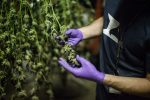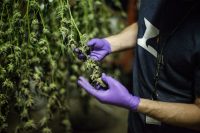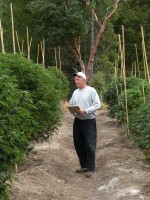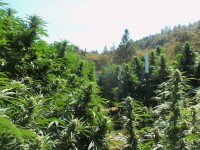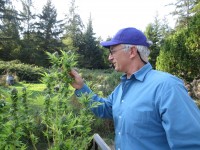With recent changes in federal and state law, and growing consumer awareness, the long-dormant hemp industry may finally be able to take heed of George Washington’s advice, “Make the most you can of [India Hemp] … The Hemp may be sown anywhere.”1
Hemp has a long and varied history in the United States. Throughout his lifetime, George Washington cultivated hemp at his Mount Vernon Estate, and, for a time, Washington even considered replacing tobacco with hemp as the Estate’s primary cash crop.2 Like Washington, Thomas Jefferson grew hemp at Monticello and his lesser-known Poplar Forest plantation.3 Both Founding Fathers primarily used the hemp cultivated on their property for making household items like clothing, rope, and fishing nets.
From the colonial era until 1970, hemp was routinely cultivated across the United States for industrial use. But, with the passage of the Controlled Substances Act (“CSA”) in 1970, U.S. hemp production ceased.4 The CSA banned cannabis of any kind, eliminating any distinction between hemp and other types of cannabis. As a result, hemp production became illegal in the United States.

More recently, the U.S. government finally began to ease restrictions on hemp cultivation and production. The 2014 Farm Bill introduced the USDA Hemp Production Program.5 Under the Program, universities and state departments of agriculture are allowed to cultivate hemp if:
- The industrial hemp is grown or cultivated for purposes of research conducted under an agricultural pilot program or other agricultural or academic research; and
- The growing or cultivating of industrial hemp is allowed under the laws of the state in which such institution of higher education or state department of agriculture is located and such research occurs.
The 2014 Farm Bill did not remove hemp from the auspices of the CSA, nor did it address the continuing application of federal drug control statutes to the growth, cultivation, manufacture, and distribution of hemp products.
The 2018 Farm Bill built upon the deregulation that began in 2014.6 Although both the 2014 and 2018 bills define hemp as the plant Cannabis sativa L. and any part of that plant that has a delta-9 THC concentration of 0.3% or less by dry weight,7 the 2018 Farm Bill took the additional step of removing hemp from the federal list of controlled substances and categorized it as an agricultural product. As a result, the production of hemp is now subject to USDA licensure and regulation. However, until the USDA completes its rulemaking process for implementing hemp regulation, hemp production remains illegal unless done in compliance with the terms of the earlier 2014 bill.8 For the time being, legal cultivation of hemp still must occur in a state that has authorized hemp research9 and the researcher must be either an institute of higher education or a state department of agriculture (or its designee).
With the increasingly favorable changes to federal and state law allowing for the expanded cultivation and production of hemp in the United States, the market is expected to grow significantly in the coming years. In 2014, the U.S. industrial hemp market was estimated at approximately $504 million.10 In only one year after the passage of the 2014 Farm Bill, the industrial hemp market was estimated to have increased by over $95 million to almost $600 million. By 2017, the worldwide market for industrial hemp was estimated to be $3.9 billion and growing at a compound annual growth rate (CAGR) of 14%.
In addition to favorable changes in U.S. law, the hemp market is benefiting from growing consumer awareness and demand for hemp-based food products.11 High in omega-3 and omega-6, amino acids and protein, hemp is growing in popularity as a cooking oil, dairy substitute, flour source and bakery ingredient. Among other things, hemp is considered by some to provide positive health effects for those seeking help with insulin balance, cardiac function, mood stability, and skin and joint health.
 Although hemp cultivation is now allowed in the U.S.—at least for research purposes—and the market is forecasted to rise steadily under growing demand for hemp-based products, broad access to viable, legal seeds continues to present a challenge for researchers and commercial growers. In order to legally implement authorized cultivation programs and take economic advantage of a swiftly growing market, farmers must have access to seeds that can be guaranteed to consistently produce plants that fall under the legal definition of hemp. In an attempt to alleviate the problem, several states, including California, Indiana, Maine and Oregon, have implemented programs to license or certify compliant seed distributors and producers.
Although hemp cultivation is now allowed in the U.S.—at least for research purposes—and the market is forecasted to rise steadily under growing demand for hemp-based products, broad access to viable, legal seeds continues to present a challenge for researchers and commercial growers. In order to legally implement authorized cultivation programs and take economic advantage of a swiftly growing market, farmers must have access to seeds that can be guaranteed to consistently produce plants that fall under the legal definition of hemp. In an attempt to alleviate the problem, several states, including California, Indiana, Maine and Oregon, have implemented programs to license or certify compliant seed distributors and producers.
The importance of hemp seed availability and development has also been recognized on the federal level. On April 24, 2019, the USDA Agricultural Marketing Service published a Notice to Trade announcing that the USDA’s Plant Variety Protection Office (“PVPO”) is now accepting applications of seed-propagated hemp for protection under the Plant Variety Protection Act (“PVPA”). Among other things, the PVPA provides intellectual property protection to breeders who have developed new varieties of seed-propagated plants. Under the new guidance, breeders of new hemp varieties can now secure protection pursuant to the PVPA. Those holding a certificate of protection from the PVPO can exclude others from marketing or selling a registered hemp variety and manage how other breeders and growers use their protected variety.
The process for requesting protection under the PVPA is fairly straightforward. Breeders, or their attorneys, must complete all application forms, pay the required fees,12 submit a distinct plant variety name, and provide a deposit of at least 3,000 viable and untreated seeds of the variety (or 3,000 seeds of each parent variety for a hybrid). One required form for a completed PVPA application is the Objective Description of Variety form.13 This form provides a series of questions that identify the distinct aspects of the variety in question, including, among other things, plant and leaf characteristics, seed properties and anticipated uses. Upon receipt of the completed application and fees, the PVPO examines the application to determine whether the listed plant variety is new, distinct, uniform, and stable. If the PVPO determines that the requirements are satisfied, it will issue a certificate of protection granting the owner exclusive rights to the registered variety for a period of 20 years.Now is the time for farmers, researchers, and hobbyists alike to take advantage of the expanded opportunities available for protecting intellectual property for proprietary hemp varieties.
Although hemp has traditionally been used in the textile and fiber industries, the estimated 17.1% CAGR in the hemp seed segment is being driven by the increase in demand for hemp oil, seedcakes, and other food and nutraceutical products. These products are primarily derived from the hemp seed as opposed to its fibers. Presently, hemp seeds contain approximately 30-35% oil, of which approximately 80% is essential fatty acids, and 25% crude protein.14 Under the new PVPA guidelines, if a breeder is able to cultivate a sustainable plant that increases the plant’s production of the desirable compounds, he or she could achieve a significant position in the growing market.
The protection provided by the newly expanded PVPA builds upon other avenues of intellectual property protection now available to hemp breeders and growers. In addition to the PVPA, plants meeting certain criteria may also be protectable under a plant patent or a utility patent, both of which are administered by the U.S. Patent and Trademark office. Generally speaking, PVPA protection may be available for seeds and tubers, plant patent protection applies to asexually propagated plants, and utility patent protection may be available for genes, traits, methods, plant parts and varieties.15
With a market that is expected to grow substantially in the near future, and with the passing of increasingly friendly federal and state legislation, the hemp industry is on the cusp of significant expansion. Now is the time for farmers, researchers, and hobbyists alike to take advantage of the expanded opportunities available for protecting intellectual property for proprietary hemp varieties.
- George Washington to William Pearce, 24 February 1794.
- George Washington and Agriculture, https://www.mountvernon.org/library/digitalhistory/digital-encyclopedia/article/george-washington-and-agriculture, last visited May 14, 2019.
- Hemp, Thomas Jefferson Encyclopedia, https://www.monticello.org/site/research-and-collections/hemp, last visited May 14, 2019.
- Controlled Substances Act, Pub.L. 91-513, 84 Stat. 1236.
- Agricultural Act of 2014, Pub.L. 113-79.
- Agriculture Improvement Act of 2018, Pub.L. 115-334.
- Any plant having a THC content in excess of 0.3% is considered marijuana and remains illegal as a controlled substance under the CSA.
- See, e.g., https://www.ams.usda.gov/rules-regulations/farmbill-hemp.
- To date, at least 41 states have passed legislation authorizing hemp cultivation and production programs consistent with federal law. As of the date of this article, those states that have not enacted legislation allowing the cultivation of hemp for commercial, research, or pilot purposes include: Connecticut, Georgia, Idaho, Iowa, Louisiana, Mississippi, Ohio, South Dakota, Texas, and the District of Columbia.
- Industrial Hemp Market – Market Estimates and Forecasts to 2025, Grand View Research, https://www.grandviewresearch.com/industry-analysis/industrial-hemp-market, last visited May 14, 2019.
- Currently, the Food and Drug Administration prohibits hemp-based CBD in food and beverages. However, the FDA has set a public hearing to discussing the legalization of CBD in food and beverages for May 31, 2019.
- The PVPA application fee is currently $4,382 with an additional fee of $768 due upon issuance of a certificate of registration.
- The Objective Description of Variety form for Hemp (Cannabis sativa L.) can be found at https://www.ams.usda.gov/sites/default/files/media/113HempST470.pdf.
- Hemp Seed (Cannabis sativa L.) Proteins: Composition, Structure, Enzymatic Modification, and Functional or Bioactive Properties,Sustainable Protein Sources (Ch. 7), R.E. Aluko (2017).
- Regulations are currently under consideration that could expand or otherwise modify the scope of protection available under each of the enumerated intellectual property protection schemes. Consult a licensed attorney for questions regarding the specific program that may apply to a particular set of circumstances.











